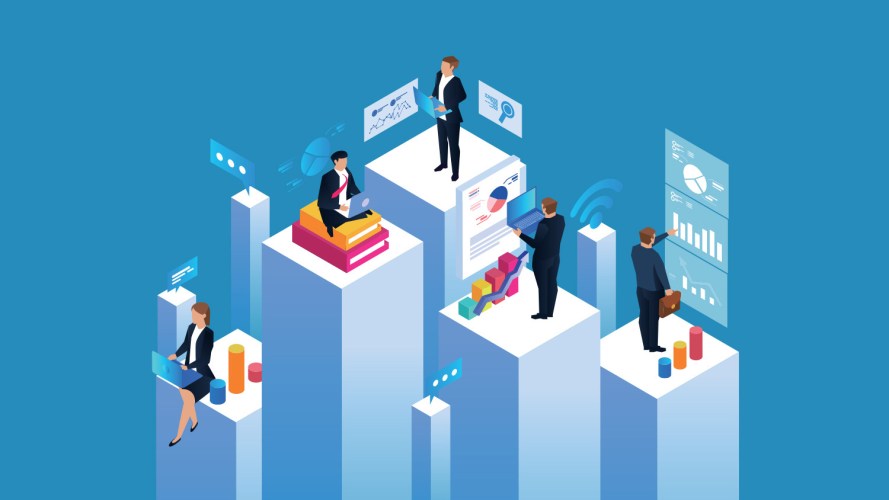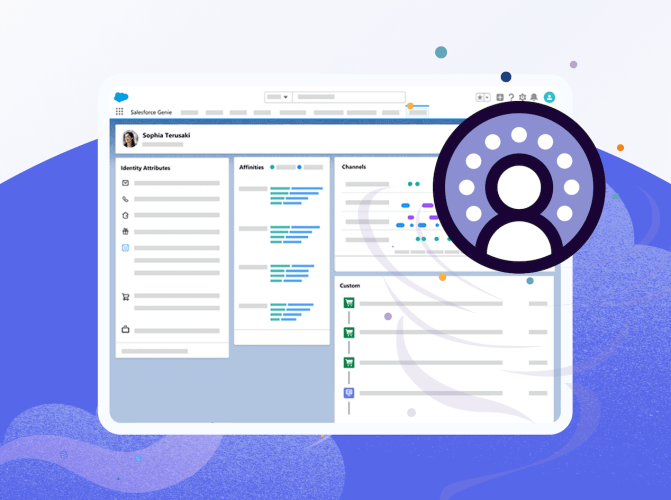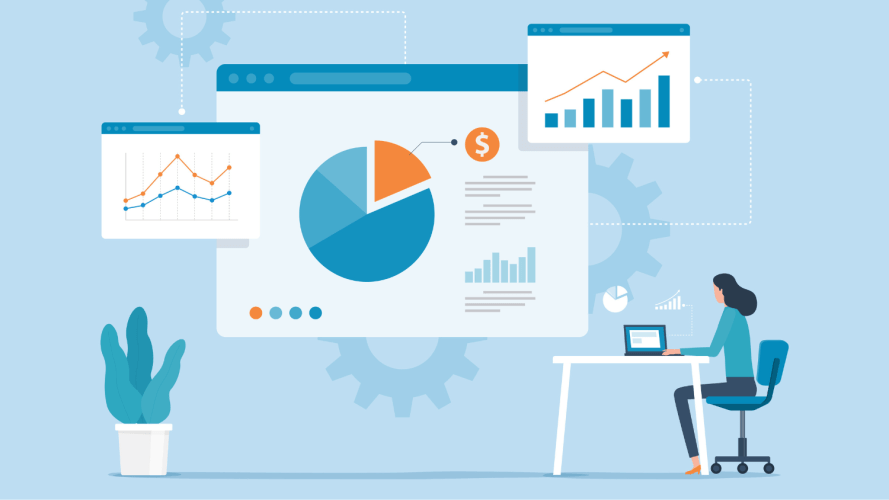The Definitive Data Glossary for Business Leaders

Global data will double every 12 hours by 2025. This glossary of data terms will help everyone in your company understand the power of real-time, actionable data in the age of generative AI.

Andy Cotgreave
The amount of data generated globally will double every 12 hours by 2025. With this much data moving through your organization, you’ll need to empower everyone, not just the data experts. Artificial intelligence (AI) will help help teams fish business insights from oceans of information, but to learn and improve decision-making, AI in turn requires data. That’s why we’ve created this glossary of data terms, so everyone in your organization – from senior leaders to individual practitioners – can become data literate now.
Getting familiar with these essential terms will help you and your teams, regardless of technical ability, feel confident talking about data and understanding how to use it to create business value.
Data Terms by Topic
Basic Data Terms
Storing & Managing Data
Batch processing
Batch processing is when a computer automatically runs a repetitive task or group of tasks on a large amount of data, processing it as a single unit rather than a series of separate jobs. Certain processor-intensive tasks can be inefficient to run individually; with batch processing, the data jobs are run together, often at an off-peak time to conserve computer resources.
- What it means for customers: When jobs like order processing are run as a batch, customers experience quicker turnaround times than when those tasks are handled individually, as well as more consistent and accurate results.
- What it means for teams: Teams save time by minimizing the overhead required for individual tasks, and gain more consistent quality control by using standard business rules across a batch process.
Business analytics
Business analytics is the practice of using data to test hypotheses and make predictions or more informed decisions, often around future performance. Business analytics is predictive, which means you model and analyze data to identify new insights and anticipate trends.
- What it means for customers: Customers get improved experiences across the board, including personalized product recommendations and just the right marketing messages, delivered at just the right time.
- What it means for teams: Teams get ahead of the curve with business analytics, using it to help them create more accurate predictions, and make smarter decisions about resource planning, demand forecasting, risk assessment, and more.
Business intelligence
Business intelligence is the practice of bringing together large amounts of data to view a current snapshot of performance, and pulling actionable insights to drive decisions. Business intelligence is descriptive, which means it “describes” what’s happening at a particular moment in time.
- What it means for customers: When organizations can see how their past or current efforts have (or haven’t) worked, and use these insights to make improvements, they’re better able to serve their customers, which leads to an increase in customer satisfaction and loyalty.
- What it means for teams: Teams use business intelligence for internal efforts, like tracking key performance indicators (KPIs), and external efforts, like spotting business risks within departments or teams, such as monitoring customer satisfaction (CSAT) scores.
Customer data platform (CDP)
A CDP helps businesses collect, organize, and use customer data from sources like websites, mobile apps, emails, and social media to build unified profiles of their customers.
- What it means for customers: With a CDP, companies can better anticipate customer needs for more meaningful brand interactions that help solve customer problems.
- What it means for teams: With a unified view of their customers, teams can create more meaningful and targeted experiences, campaigns, and products. They’re also better able to track, measure, and improve as more data comes in.
Dashboard
A dashboard is a visual display of data used to monitor conditions or facilitate understanding. Dashboards generally include multiple interactive charts describing important business processes and KPIs.
- What it means for customers: Organizations that can monitor their processes effectively can produce targeted insights that better serve customers’ needs.
- What it means for teams: By monitoring progress towards key business goals, dashboards let people see positive and negative trends, and drill into the reasons that cause them, allowing them to take action.
Data analytics
Data analytics is the science of examining raw data to draw conclusions. It includes tools and technologies that make it easier to understand, aggregate, and visualize data.
- What it means for customers: Customers experience the benefits of data analytics when they engage with improved products and services.
- What it means for teams: Teams use data analytics for continuous improvement across key functions like customer service, product development, marketing, and more.
Data and big data
Data is the raw facts, figures, and other information, like customer names and contact details, that organizations collect, store, and analyze. Data can come from different sources, like customer interactions, surveys, sensors, and social media. Big data means large and complex amounts of information. The five V’s of big data — volume, velocity, veracity, value, and variety — describe the challenges of storing, governing, and analyzing it in structured, unstructured, and semi-structured forms.
- What it means for customers: When companies use big data, customers not only receive more tailored and relevant messaging. They also benefit from increased security and trust, since big-data analysis spots patterns that identify fraudulent behavior.
- What it means for teams: Teams use data to create better customer interactions. They collect and analyze data related to past purchases, browsing behavior, and other data points to recommend specific products or services. That enhances customer experience and increases the odds of a purchase.
Unlock, analyze, and act on your data
Data can speed up your organization’s digital transformation. Power your data analytics with a scalable data integration strategy that unifies all your data sources.



Data culture
A data culture is the shared behaviors and beliefs of individuals who advocate for and prioritize using data to enhance decision-making. A data culture empowers everyone, not just data analysts, to unlock and create business value with data.
- What it means for customers: When every person in the organization is empowered to use data, everyone can make smarter decisions about what the customer needs.
- What it means for teams: Teams solve problems faster. With data at the forefront, they get ahead of trends, create more tailored offerings, improve forecasting, and more.
Data governance
Data governance is the framework organizations use to define the rules and responsibilities for effective handling of data throughout its lifecycle to ensure its reliability and relevance. These rules define processes and protocols to maintain usability, quality, policy compliance, privacy, and security.
- What it means for customers: Having reliable and relevant data is essential to creating quality customer experiences. Plus, customers are more likely to trust an organization that demonstrates respect for their privacy rights and sensitive personal information.
- What it means for teams: Teams have more peace of mind knowing that data is reliable and relevant, and that clear standards and practices exist to protect data to reduce the likelihood of a breach.
Data harmonization
Data harmonization is the process of bringing together data from multiple sources to create a unified dataset that functions as if it were a single data source. It involves aligning data elements, formats, and structures to eliminate inconsistencies and make the data easier to compare and analyze.
- What it means for customers: Customers get a consistent experience across departments because organizations can access data, like customer preferences and purchase history, from various sources as if it were a single source.
- What it means for teams: Teams have a more holistic view of customers and can access and analyze information more quickly, without having to access multiple systems.
Data insights and real-time insights
Data insights are key findings, like data patterns and trends, that you get from data analysis. Real-time insights are the immediate and up-to-date information from data analysis that comes in the moment an event occurs, such as sales through an ecommerce site. You can use these insights to guide decision-making and strategies.
- What it means for customers: Data insights lead to key customer benefits across all brand interactions, including more tailored products and services, and proactive support. With real-time insights, organizations can create real-time personalization, more targeted marketing, and nearly immediate responses to issues.
- What it means for teams: Teams build a competitive advantage in the market, using data insights to gain a deeper understanding of customers, improve processes, and fuel smart decisions.
Data lake
A data lake is a centralized storage repository of raw data. It’s a vast, flexible, and low-cost storage system organizations use to collect and store large volumes of structured, unstructured, and semi-structured data in its original format. Data lakes capture a wealth of unstructured data like social media posts, sensor logs, and location data.
- What it means for customers: With the immense information available in a data lake, brands can anticipate customer wants and needs.
- What it means for teams: Teams access a huge amount of data in a single space, allowing them to move faster and keep up (or get ahead of) competitors.
Data lakehouse
A data lakehouse has the scalability and flexibility of a data lake, and the structure and governance of a data warehouse — the best of both worlds. Because of this hybrid quality, organizations can quickly and easily extract insights from all their data, regardless of format or size.
- What it means for customers: Customers benefit from unified omnichannel experiences, quicker response times, and improved data security.
- What it means for teams: Teams eliminate the need for separate data storage and processing structures, which allows them to unify historical and real-time data all in one place.
Data literacy
Data literacy is the ability to explore, understand, and communicate with data.
- What it means for customers: Customers want to know brands understand them and can help them solve their problems. Organizations that embrace data literacy can have this kind of in-depth knowledge across customer touchpoints.
- What it means for teams: Teams with strong data literacy skills build personal, professional, and organizational growth, increasing critical thinking, career opportunities, and data-driven success.
Top data security trends
Data security, compliance, and governance are always top priorities. Here, 300+ IT leaders detail must-have tools for their data security toolkit.



Data masking
Data masking is the process of replacing sensitive data with fictitious or anonymized data to protect sensitive or private information and to comply with privacy requirements. Data masking is used in training or testing scenarios when real data is not needed, or when sharing data with third parties. You can also use masking to ensure you’ve eliminated all personal data when writing AI prompts or training an AI model.
- What it means for customers: Customers feel more confidence when companies protect sensitive and personally identifiable information.
- What it means for teams: Teams can easily follow privacy requirements while still having functional data to use in testing, training, or development.
Data mining
Data mining is the process of discovering patterns in large datasets. It uses techniques like machine learning, statistics, and database systems to turn raw data into useful information.
- What it means for customers: Your customers get predictive recommendations about what they want and need, often before they know they need it. Customized recommendations, reminders, and add-on product offerings are all powered by data mining.
- What it means for teams: A deeper understanding of customer behavior keeps all your marketing and sales strategies efficient and effective.
Data science
Data science is a field that combines scientific methods, statistics, algorithms, and data mining techniques to generate insights from structured and unstructured data.
- What it means for customers: Customers experience faster service and improved personalization with data science tools like recommendation algorithms, which provide tailored suggestions and machine learning algorithms that automate specific support tasks.
- What it means for teams: Teams use data science to continually improve and iterate on service and product offerings to create more relevant, efficient, and satisfying customer experiences.
Data security
Data security refers to the measures and practices used to protect an organization’s data, like user permissions and role-based access, to ensure only authorized individuals have access to specific data.
- What it means for customers: Customer trust is everything. When customers know that an organization takes great care in protecting their data and privacy, it builds relationships and loyalty.
- What it means for teams: When teams have data security measures in place, they protect themselves from data breaches, maintain customer trust and reputation, ensure they comply with regulatory standards, and even safeguard intellectual property.
Data storytelling
Data storytelling is the use of data, visualizations, and narratives to communicate insights and convey a compelling story to an audience. You can create stories to tell a data narrative, provide context, demonstrate how decisions relate to outcomes, or simply make a compelling case.
- What it means for customers: Organizations use data storytelling to create a deeper, more meaningful understanding of their customers.
- What it means for teams: Teams use data storytelling to simplify complex information, and share it in an engaging way across their organization. This improves understanding and buy-in of key data concepts and related projects.
Data visualization
Data visualization is the practice of creating detailed charts, graphs, and maps to make information easier to understand. This helps organizations better spot trends and patterns in data, and allows nontechnical people to understand and make sense of data.
- What it means for customers: Customers have more connected interactions with a brand when organizations are on the same page about data insights.
- What it means for teams: Teams enrich their understanding of data and uncover hidden insights with rich visualizations.
Data warehouse
A data warehouse is a large, organized storage space for processed data, where an organization collects and stores information from different sources in a structured way.
- What it means for customers: Customers expect their interactions with a brand to be seamless. Organizations meet this expectation better when they have all their data organized in a single place.
- What it means for teams: Teams have a central hub for data, which gives them quick access whenever they need it for reporting, decision-making, and more.
Predictive analytics
Predictive analytics uses statistical techniques (including machine learning) to predict future events or outcomes based on historical data. In the context of CRM, this might involve predicting which customers are most likely to churn, or which are most likely to respond to a certain promotion.
- What it means for customers: With predictive analytics, customers receive the information and promotions that are most interesting and relevant to them.
- What it means for teams: Teams can use predictive analytics to forecast demand, identify trends, make proactive decisions, and inform business strategies.
Secure data retrieval
In generative AI, secure data retrieval means that for each generative prompt — like, what’s our sales forecast? — data and outputs are delivered in a way that upholds permission levels and governance policies so users get only information they’re authorized to see.
- What it means for customers: Customers can better trust an AI system that keeps data secure throughout the process.
- What it means for teams: Teams can confidently prevent unauthorized data access because permissions are maintained at every stage.
Structured, unstructured, and semi-structured data
Structured data is well-defined data in a fixed format, such as a spreadsheet or customer database, with rows for each customer and columns for name, address, phone number, and email. Structured data is easily understandable, searchable, and machine-readable by traditional analytics tools.
Unstructured data is information that doesn’t have a predefined format or specific data model, and requires specialized tools to create insights. Examples of unstructured data include emails, social media posts, audio and video recordings, images, and web pages. Because unstructured data is growing at a higher rate than structured data, big data technologies that can seamlessly analyze it will be crucial to businesses.
Semi-structured data has some organizational structure but isn’t easy to analyze as-is; it needs some organizing or cleaning to be imported into a relational database like structured data.
- What it means for customers: Brands that take advantage of different data types can better serve their customers by deriving insights from more quantitative structured data and more qualitative unstructured data.
- What it means for teams: Teams can use all three data types for analysis, with a combination of solutions like Hadoop for ingesting unstructured data, and Tableau for analyzing and visualizing structured and semi-structured data.
Take the next step with data
Data is more important now than ever, and the ever-expanding flow of data is a huge management and governance responsibility. But data holds great power. The more you expand data access and data literacy for individuals throughout your organization, the greater the potential for business insights that can guide decision-making and create incredible customer experiences. When you combine real-time, actionable data with AI and CRM, it can drive intelligent actions and deliver personalized experiences at scale.
That’s why it’s important to understand the data essentials. When data literacy spreads throughout your company culture, anyone can gain insight with data and create value.
Your data is gold – here’s how to harness its full value
When you get your data, AI and CRM together, you can connect, visualize, and explore all of it to get unified insights for your entire organization.


























